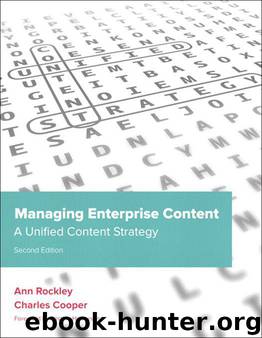Managing Enterprise Content: A Unified Content Strategy (2nd Edition) (Voices That Matter) by Ann Rockley & Charles Cooper

Author:Ann Rockley & Charles Cooper [Rockley, Ann]
Language: eng
Format: mobi
Publisher: Pearson Education
Published: 2012-02-13T14:00:00+00:00
Figure 14.5. Sample review and approval workflow.
Documenting your existing workflow can be a great first step toward an effective unified content strategy, but your ultimate goal is to try to improve—or simplify—your current processes. Accordingly, your first draft flowcharts may show processes in their current state, but your unified content lifecycle workflows could show your processes as they will support your unified content strategy.
Designing effective workflow
The components of an effective workflow are players, their responsibilities (or tasks), and the processes they all follow. Designing an effective workflow involves analysis of players and their tasks, as well as identification of patterns and interactions, then documenting of detailed tasks, followed by testing.
To design effective workflow, follow these steps, referring to your content lifecycle:
• Understand your current workflow. In most cases organizations have only a vague idea of how their content is created and managed. We recommend that before you design your new workflow, you examine, and if necessary, document your current workflow. It’s hard to know where you want to go if you don’t know where you are. You need to ensure you understand your current workflow and learn what doesn’t work, what works but could be better, and what works really well. Only when you have a solid understanding of what your current problems and successes are should you attempt to develop a new workflow.
• Determine a starting point for your new workflow. Usually a process starts with an incoming event, such as a new eBook or app coming to the market, or a request to update existing documentation. A starting point can also be a crisis that you need to respond to. If you include tasks that are not part of the automated workflow, indicate where automated workflow begins.
• Figure out a logical place for the workflow to end. This is typically when the incoming event that triggered the beginning has been handled satisfactorily. In a unified content lifecycle, content must be stored in the repository for the event to be considered complete.
• Identify all players from the beginning to the end of the workflow. Identify players by their roles rather than by their names. A task should be associated with a role to accommodate people moving in and out of jobs. If tasks are assigned to roles, then the task stays with the role regardless of where particular people move in your organization. If you assign tasks to people, you’ll need to go into your workflow system and make changes every time those people change jobs.
• Remember that your CMS is a player too. It will handle notifications, reports, and all of the bothersome tracking that we hate doing. If you don’t define what you want the system to do, employees will end up tracking files and sending notifications—exactly what we don’t want to happen.
• Sketch the tasks. Start by identifying all the tasks that belong to each player, including when they’re waiting for something else to happen, or when they’re handing off work to someone else. Remember to write tasks clearly so that everyone who looks at the flow knows exactly what the task is about.
Download
This site does not store any files on its server. We only index and link to content provided by other sites. Please contact the content providers to delete copyright contents if any and email us, we'll remove relevant links or contents immediately.
Hello! Python by Anthony Briggs(10123)
The Mikado Method by Ola Ellnestam Daniel Brolund(10013)
Dependency Injection in .NET by Mark Seemann(9518)
Sass and Compass in Action by Wynn Netherland Nathan Weizenbaum Chris Eppstein Brandon Mathis(7915)
Svelte with Test-Driven Development by Daniel Irvine(7833)
The Well-Grounded Java Developer by Benjamin J. Evans Martijn Verburg(7770)
Test-Driven Development with PHP 8 by Rainier Sarabia(7568)
Layered Design for Ruby on Rails Applications by Dementyev Vladimir;(7395)
Web Development with Django by Ben Shaw Saurabh Badhwar(6902)
Secrets of the JavaScript Ninja by John Resig Bear Bibeault(6641)
Secrets of the JavaScript Ninja by John Resig & Bear Bibeault(6634)
React Application Architecture for Production by Alan Alickovic(6588)
Jquery UI in Action : Master the concepts Of Jquery UI: A Step By Step Approach by ANMOL GOYAL(5873)
Kotlin in Action by Dmitry Jemerov(5299)
Software Architecture for Web Developers by Mihaela Roxana Ghidersa(4811)
Audition by Ryu Murakami(4767)
Accelerating Server-Side Development with Fastify by Manuel Spigolon Maksim Sinik & Matteo Collina(4654)
Hands-On Full-Stack Web Development with GraphQL and React by Sebastian Grebe(4385)
Solidity Programming Essentials by Ritesh Modi(4383)
